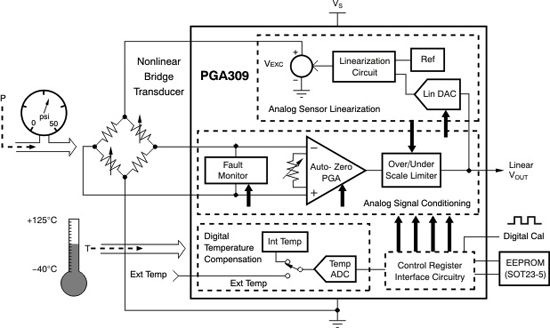Sensor data acquisition underlies many deeply embedded applications and plays a central role in the evolving Internet of Things (IoT). With the trend toward reliance on energy harvesting for power, sensor-based designs require increasingly effective solutions for processing sensor signals efficiently and accurately. Among available alternatives, specialized sensor-signal conditioning ICs such as those from Analog Devices, Maxim Integrated, and Texas Instruments offer a drop-in solution for sensor-signal acquisition.
Sensors typically produce small signals that require amplification to boost the dynamic range of the signals, as well as compensation to correct for offset, temperature, and non-linearity response of the sensors themselves (Figure 1). To meet these challenges, designers can turn to a variety of digital and analog methods.
Figure 1: Integrated sensor-signal conditioner ICs combine analog signal paths with digital control features using dedicated digital-analog converters (DACs) to support excitation, compensation, and linearization required in sensor designs (Courtesy of Maxim Integrated).
Sensor-signal processing
Digital signal processing (DSP) methods offer a highly flexible alternative for sensor data acquisition. With a DSP-based approach, amplification, compensation, and correction all occur strictly in the digital domain after signal conversion by an analog-digital converter (ADC). With this approach, however, signals remain within a limited dynamic range, requiring more expensive, higher-resolution ADCs to achieve required precision levels. Furthermore, DSP methods shift design complexity to digital systems, resulting in higher memory requirements and greater software complexity than many deeply embedded applications the IoT can easily support.
In contrast, signal conditioning performed in the analog domain achieves sensor calibration and temperature compensation without incurring the error associated with digital processing of a quantized signal. Yet, discrete solutions can quickly become highly complex with increased sensor complexity and more demanding application requirements. For example, more complex sensor types, such as bridge sensors, require amplifiers be able to amplify the differential-input voltage and reject the common-mode input voltage. Accordingly, engineers working with these types of sensors need to take extra care to ensure use of matched resistors and amplifiers.
For more detail: Signal Conditioners Offer Drop-in Sensor Solutions for Energy-Harvesting Designs

